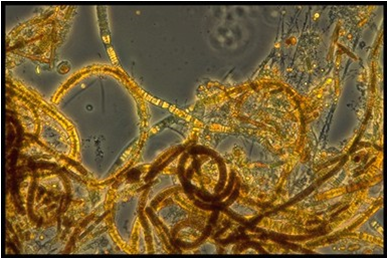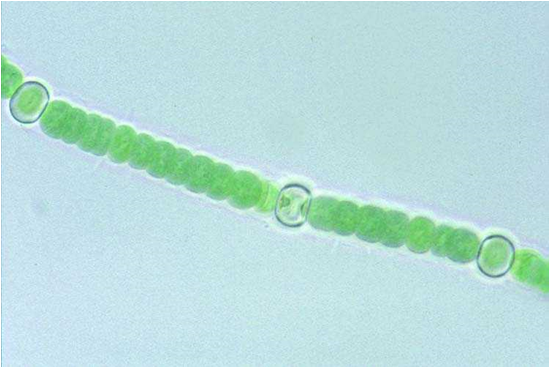Nodularia Spumigena
Classification
Bacteria; Cyanobacteria; Nostocales; Nostocaceae; Nodularia;
Species
Nodularia spumigena
Description and Significance
Nodularia spumigena is a filamentous, planktonic, photosynthetic, diazotrophic, bloom-forming cyanobacterium.It is usually found in salty or brackish waters. It is one of the dominating species during the extensive cyanobacterial blooms in the Baltic Sea, which are one of the largest in the world. It is also found in Lake Alexandrina, in the south-east of southern Australia. The first documented outbreak was recorded by Francis in 1878. It is commonly found near the surface of the water because is has a high tolerance of ultraviolet radiation.
Genome Structure
The genome sequencing is currently underway at the Gordan and Betty Moore Foundation Microbial Genome Sequencing Project, but it not yet finished. The DNA length is 5,316,258 nt (5 Mb). The G-C content is 42.0%. There are 4860 genes coded for and 80% of the genome is coded. The number of chromosomes and shape of the genome is not yet known.
Cell Structure, Metabolism and Life Cycle
Nodularia spumigena has a photosynthetic metabolism. It has a filamentous structure including enlarged cells called heterocysts. These heterocysts are specialized cells for atmospheric nitrogen fixation. No photosynthesis occurs in these specialized cells. It is responsible for a large part of the new nitrogen input into the Baltic Sea. Mycosporine like amino acids (MAAs) are produced as a photo-productive strategy against ultraviolet radiation. This allows the organism to live closer to the surface of the water, while other cyanobacteria must live in deeper waters.
Ecology and Pathogenesis
Nodularia spumigena produces the hepatoxin nodularin. Hepatoxins are toxins which affect the liver. Nodularin is a tumor promoter known to have killed wild and domestic animals by seriously affecting the liver. It is a liver carcinogen due to the inhibition of protein phosphataes. Research is focused on environmental factors affecting growth and toxin production. Higher salinity levels and lower ultraviolet radiation leads to more production of the nodularin toxin.
References
Hobson, P. et al. "Effect of irradiance, temperature and salinity on growth and toxin production by Nodularia spumigena." Hydrobiologia 493(2003): 7-15. Print.
Tuomainen, Janna. et al. "Community Structure of the Bacteria Associated with Nodularia sp. (Cyanobacteria) Aggregates in the Baltic Sea ." Microbial Ecology 52(2006): 513-522. Print.
Huber, A.L.. "Phosphatase activities in relation to phosphorus nutrition in Nodularia spumigena (Cyanobacteriaceae) ." Hydrobiologia 123(1985): 81-88. Print.
Mazur-Marzec, Hanna. et al."The effect of salinity on the growth, toxin production, and morphology of Nodularia spumigena isolated from the Gulf of Gdańsk, southern Baltic Sea ." Journal of Applied Phycology 17(2005): 171-179. Print.
Vuorinen, Pekka. et al."Accumulation and Effects of Nodularin from a Single and Repeated Oral Doses of Cyanobacterium Nodularia spumigena on Flounder ( Platichthys flesus L.) ." Archives of Environmental Contamination and Toxicology (2008).
Staal, M., te Lintel-Hekkert, S., Harren, F., Stal, L.J. (2003) Light action spectra of nitrogenase activity in Baltic Sea cyanobacteria. Journal of Phycology 39: 668-677.
Purdue Cyanobacterial Image Gallery
Author
Page authored by Charlie Teater, student of Prof. Jay Lennon at Michigan State University.


